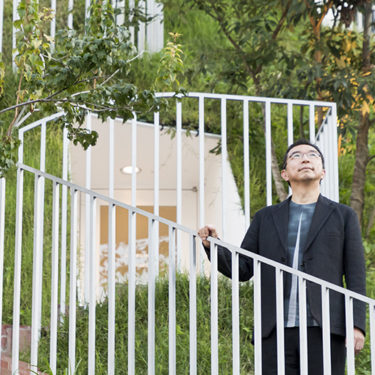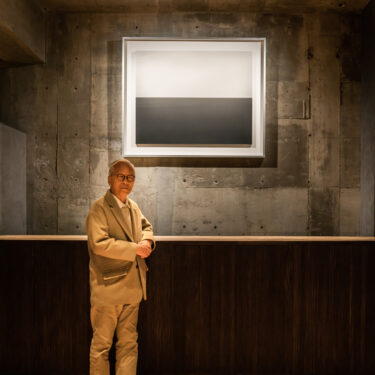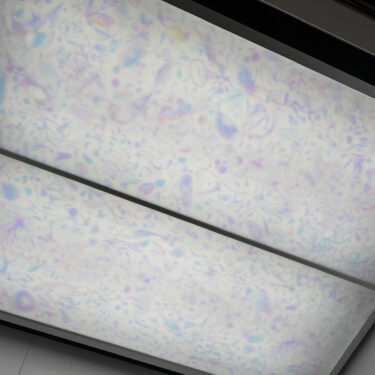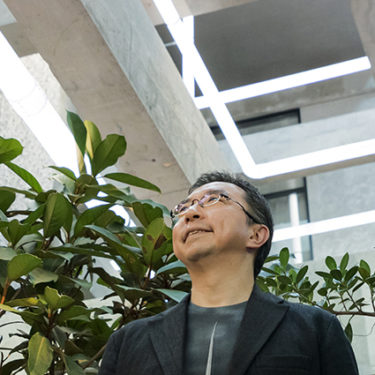ROOM 20 白川 昌生 / YOSHIO SHIRAKAWA
上毛三山 / Three Mountains of Jomo

妙義 / Myogi

赤城 / Akagi

榛名 / Haruna
1948年福岡県生まれ。1970年に渡欧、ストラスブール大学文学部哲学科にて哲学を専攻。1972年ストラスブール州立美術学校入学。1974年、パリ国立美術学校入学、1981年、国立デュッセルドルフ美術大学を卒業。デュッセルドルフ時代にヨーゼフ・ボイスの「社会彫刻」の思想に強く影響を受ける。1983年には、「日本のダダ 1920-1970」展をデュッセルドルフ市立美術館で企画するなど日本の前衛美術をヨーロッパに紹介する活動も行った。1983年に帰国の際、群馬県白根開善学校高等部に職を得たことをきっかけに、吾妻郡六合村に住み始める。1984年には、「日本の前衛 1920-1970」展を企画(東京大学教養学部美術博物館)。1989年から北関東造形美術専門学校に勤務し、勢多郡大胡町(現・前橋市大胡町)に移住。群馬という自分の住む場所をテーマに作品制作に取り組む。1993年に、「場所・群馬」成立宣言を行い、芸術における地域性に早い時期に注目をした。また、美術家としての制作活動のほかに、精力的に執筆活動を行う。主な著書に、『贈与としての美術』(水声社、2014年)、『美術・神話・総合芸術 贈与としての美術の源へ』(水声社、2019年)などがある。主な個展に2014年「白川昌生 ダダ、ダダ、ダ 地域に生きる想像の力」(アーツ前橋、群馬)など。前橋の弁天通商店街を舞台に描かれた《駅家の木馬祭り》は、白川が創作した架空のお祭りであるが、物語が生まれた2011年から毎年形を変えてお祭りが開催されている。
本作は、白井屋ホテルの客室のために描かれた3点のドローイングである。描かれているのは群馬に暮らす人々には馴染み深い上毛三山。前橋からは、遠方にどの山も望むことができ、この街の日常を見守る郷土の風景と言える。白川は、それぞれの山の描く稜線をヒントに造形的な形に落とし込んでいる。長方形として描かれる赤城山は、群馬県民が幼い頃から親しむ「上毛かるた」でも謳われるように関東平野に続いていく「長し裾野」として広がってゆく空間を想起させる。ドローイングに使用されるマスキングテープやごくシンプルな日常的に手に入れられる額装も白川の活動のコンセプトである自身の日常生活から芸術を捉える思想を示している。
Yoshio Shirakawa was born in Kitakyushu, Fukuoka Prefecture, in 1948. In 1970, he travelled to Europe to study philosophy at the University of Strasbourg’s Faculty of Literature. In 1972, he enrolled Strasbourg School of Art. He was admitted to the École nationale supérieure des beaux-arts in Paris in 1974, and graduated from Kunstakademie Düsseldorf in 1981. During his time in Düsseldorf, he was strongly influenced by Joseph Beuys’s concept of “social sculpture”. He also took an active role introducing Japanese avant-garde art to European audiences, organizing exhibitions such as Dada in Japan: 1920–1970 in the Kunstmuseum Düsseldorf in 1983.
After returning to Japan in 1983, Shirakawa accepted a position as a teacher at a private high school in Gunma and settled in the nearby village of Kunimura (now part of Nakanojo). In 1984, he organised the exhibition Japanese Avant-Garde Art: 1920-1970 at the University of Tokyo Komaba Museum. In 1989, he accepted a new position at the Kitakanto Fine Arts School and moved to the town of Ogo (now part of Maebashi). He is committed to using Gunma, his place of residence, as a thematic source for his creative work. Recognizing the role of locality in fine arts at an early stage, in 1993 he announced the formation of PLACE/GUNMA. In addition to his artistic activities, he is also an energetic writer. His major written works include Art as gift (Zoyo toshite no bijutsu: Suiseisha, 2014) and Art, myth, composite art: Toward the origin of art as gift (Bijutsu/shinwa/sogo geijutsu: Zoyo toshite no bijutsu no minamoto e: Suiseisha, 2019).
His solo exhibitions include Masao Shirakawa: Dada, Dada, Da (Arts Maebashi, Gunma, 2014). He also originated the Mokuba Festival (wooden horse festival) with Maebashi’s Benten Shopping Street as setting. This “imaginary observance” has been held in real life since 2011 with new ideas every year.
This work consists of three drawings produced for this room. The drawings depict the Jomo Sanzan or “Three Mountains of Jomo.” Jomo is an old name for the area that became modern-day Gunma Prefecture, and these mountains have always been a familiar presence for local residents. From Maebashi, all three can be seen in the distance, watching over everyday life in the city. Shirakawa reduces them to iconic forms, taking inspiration from the individual ridgelines of each peak. Mount Akagi is drawn as a rectangle, evoking the “long plains” (nagashi susono) at the foot of the mountain familiar from the local poetry card game Jomo karuta. Shirakawa’s use of masking tape and simple, everyday frames of the sort that can be purchased anywhere also reflects his philosophy of capturing art from everyday life.





